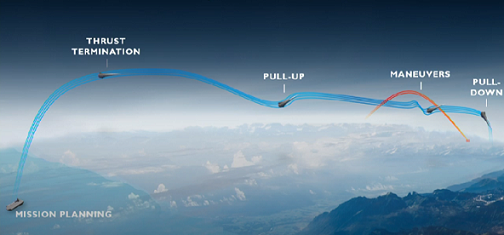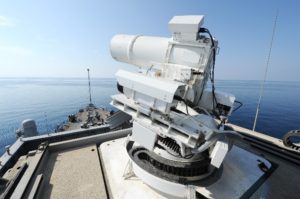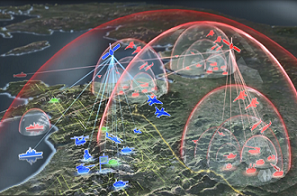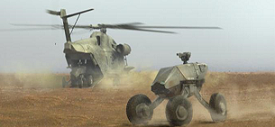[Editor’s Note: Mad Scientist Laboratory welcomes today’s guest blogger Seth Gnesin, one of this year’s Mad Scientist Initiative Summer Interns. Mr. Gnesin’s post addresses the future of hypersonics (i.e., systems that are capable of high speed [Mach 5 or higher] and highly maneuverable). Advances in hypersonic delivery systems, coupled with new types of conventional and unconventional warheads will dramatically increase the scope of battlefields, with precision strike effects capable of being delivered rapidly from a continent away. But hypersonics offer much more than just a strike capability — read on to learn more about this capability, its potential countermeasures, and how it could one day be used to project troops, swarms, and logistics in the future Operational Environment! (Note: Some of the embedded links in this post are best accessed using non-DoD networks.)]
Speed can be decisive in whether an operation succeeds, or an attack is successfully countered. One of the technological speed races centers around atmospheric hypersonic flight—faster than Mach 5 or five times the speed of sound (about 3800 mph at sea level and slower at higher altitude). Despite the current press, hypersonic development is not new. The difference from the past cycles of hypersonic development is not the focus on offensive speed but also on countermeasures and non-missile applications, neither of which are considered sufficiently in discourse on hypersonic technology. By not addressing the non-missile aspects of hypersonic development, the Army risks diminishing the dangers of hypersonic proliferation and overlooking its broad implications for the future Operational Environment.
Offensive Applications

Most hypersonic development, for both the United States and its adversaries, focuses on designing hypersonic glide vehicles (HGVs) for missiles and countering their use by other countries. HGVs are boosted out of the atmosphere by rockets where they gain their velocity before gliding across the atmosphere at hypersonic speeds and then diving to hit their target. They can be topped with nuclear or conventional warheads and do not follow predictable ballistic trajectories; rather, they skim the upper atmosphere before diving faster than Mach 5 to reach their target.
The Pentagon’s focus with HGVs, however, is not just for their speed but also their maneuverability, which sets them apart from standard ballistic missiles. Maneuverability, in this case, refers to both the agility, or turning ability, of the vehicle and the target ambiguity. Hypersonics will be unable to turn sharply in the upper atmosphere but could be agile once in the dive stage, making interception practically impossible.1 The other aspect of maneuverability refers to the area of possible targets. Unlike ballistic missiles which maintain predictable and parabolic trajectories after their boost phase, boost glide vehicles can sustain large turns in the upper atmosphere and have continent-sized target areas before diving.2 Given that ambiguity, the Pentagon’s primary goals are to ramp up production and create a deterrent arsenal to buy time to develop effective countermeasures.

Detection and Countermeasures
 Due to the speed and flattened trajectory of HGVs, current missile defense capabilities are mostly incapable of detecting or preventing a hypersonic missile attack. Current missile detection systems rely on a combination of satellite and radar readings to collect data which they relay to kinetic interception systems, like Terminal High Altitude Area Defense (THAAD) systems. Problematically, by the time the interception system reacts viewing range, the HGV can be on a different trajectory far from its detection point. To resolve this issue, the Pentagon is working to implement a dense layer of sensors in low earth orbit to track hypersonic and high-speed ballistic missiles and guide interceptors to them. These systems, however, will take years to implement while some hypersonic missiles could already be deployed. Further, orbital sensors can be interdicted via adversaries’ ASAT capabilities or degraded by complications such as Kessler Syndrome.
Due to the speed and flattened trajectory of HGVs, current missile defense capabilities are mostly incapable of detecting or preventing a hypersonic missile attack. Current missile detection systems rely on a combination of satellite and radar readings to collect data which they relay to kinetic interception systems, like Terminal High Altitude Area Defense (THAAD) systems. Problematically, by the time the interception system reacts viewing range, the HGV can be on a different trajectory far from its detection point. To resolve this issue, the Pentagon is working to implement a dense layer of sensors in low earth orbit to track hypersonic and high-speed ballistic missiles and guide interceptors to them. These systems, however, will take years to implement while some hypersonic missiles could already be deployed. Further, orbital sensors can be interdicted via adversaries’ ASAT capabilities or degraded by complications such as Kessler Syndrome.
Kinetic interception is another major challenge, especially once the HGV enters its glide phase after being boosted, but there are some solutions in development that could counter the first wave of hypersonics. DARPA and Aerojet Rocketdyne have been developing the “glide-breaker” system to intercept HGVs mid-flight, likely in the traditional sense of proximate interception. The target ambiguity, however, means ground-based interceptors will have to launch before the hypersonic missile commits, so one hypersonic missile could trigger, then evade several interceptors in an area defense system.3

Directed Energy Weapons (DEW) could prove to be more effective, and cost-effective, as HGV countermeasures than kinetic interception, and some possible DEW systems are already deployed and could be modified for use against hypersonics. By sending out high-energy pulses at light-speed, they can catch hypersonics and damage them sufficiently to disrupt their flight. The problem with laser-based systems, however, is that hypersonic vehicles are already hardened against thermal effects, so the laser would have to provide thermal flux orders of a magnitude higher than the atmospheric heating or be rendered useless – a significant challenge with both the movement of the HGV and the power output of the laser. Another DEW option is to use high-powered microwaves to achieve a “soft kill” by disrupting the vehicle’s internal electronics and preventing its control system from maintaining stability. While they have some similar issues to high-powered lasers, microwaves propagate through the atmosphere better and do not need such prolonged contact with the hypersonic to disrupt its circuits.4
Other Hypersonic Uses

Non-missile offensive applications for hypersonic technology are further in the future than missile applications but will greatly impact the FOE. Lockheed Martin is potentially developing a new generation of reconnaissance plane dubbed the SR-72, designed to travel at Mach 6. While it is being developed as a reconnaissance craft, it could easily be used as a hypersonic stealth bomber. Meanwhile, other aerospace companies are developing hypersonic passenger and cargo carriers, like Stratolaunch’s Talon A, which they hope to have in commercial service by 2023. As hypersonic vehicles can evade most air defense systems, developing hypersonics to deliver personnel, equipment, and logistics support through anti-access/area denial bubbles is a strategic priority for the Pentagon.
Hypersonic Proliferation

Hypersonic development, however, is not limited to or led by the United States. Russia claimed to have already finished their first hypersonic missile system, known as Avanguard, to be launched from atop intercontinental ballistic missiles (ICBMs), which increases the ambiguity of Russian missile launches. Russia is also in late-developmental stages for two other hypersonic weapons, the Kinzhal Air-launched Missile and the Tsirkon Hypersonic Cruise Missile, soon giving them three operational and diverse hypersonic weapons. China, meanwhile, has conducted the most successful public hypersonic tests, mainly focused on the DF-17, an ultra-precise hypersonic glide missile. While hypersonic technology will not soon be democratized due to high development costs, India and Japan are developing their own hypersonic vehicles in response to Chinese advances, and Australia is partnered with the United States to develop scramjets, another possible method of achieving hypersonic flight. Should any country deploy hypersonic missiles, as Russia seems close to doing, pressure on both developing hypersonic weapons as a deterrent and solving the problems of detection and countering will increase significantly.
The developing arms race around hypersonic technology has several implications for arms control given that no international agreements cover hypersonic weapons, and their use and sale are not regulated. Measures have been proposed, ranging from a non-proliferation agreement among the United States, Russia, and China to a comprehensive hypersonic weapons ban. Generally, arms control scholars are pushing for a full ban on hypersonic weapons, or the inclusion of hypersonic weapons in the New START treaty renegotiation, due to their inherently destabilizing nature, associated risk of miscalculation, and difficulty in countering. These solutions, however, do not fully stand up to scrutiny. A full ban on hypersonic weapons does not remove the knowledge already gained and could stunt the commercial development of hypersonic transport; and the New START solution would only bind the United States and Russia, leaving China and India, among others, to develop hypersonic missiles unchecked.
Implications for the Army

The impact of hypersonic weapons on the future Operational Environment and future Army activities will likely be significant. Even with an advanced sensor network, hypersonic weapons cut reaction time significantly, which increases the risk of miscalculation. There are, however, no current sensor systems which are capable of tracking hypersonic weapons long-term, so there is no effective way to detect, let alone intercept, an incoming hypersonic missile before it strikes. Further, kinetic interception is beyond current technological abilities, so the future focus will be on building a large hypersonic deterrent, rather than relying on a defensive system. This will likely provoke an arms race between the United States, Russia, and China, as all three countries (and perhaps others) look to develop the largest deterrent stockpile of hypersonic vehicles.
Another major concern are the convergence of nuclear and hypersonic technology, a pink flamingo for the future Operational Environment. As HGVs can be boosted from conventional missiles that carry nuclear warheads, or could be nuclear tipped themselves, the ambiguity of whether an HGV is armed with nuclear warheads will heighten the miscalculation risk. While the United States is not pursuing nuclear-armed HGVs because they do not benefit its nuclear deterrence strategy, adversaries like Russia are; so developing technology which can detect how a missile or HGV is armed will be essential in the future to prevent unnecessary escalation.

Hypersonic transport could reduce the requirement for stationing large numbers of Army formations outside the Continental United States. Moving small teams of Soldiers and equipment at hypersonic speeds could allow the Army to improve conventional deterrence in potential hotspots like Eastern Europe, the Korean Peninsula, and East Asia. Even in CONUS, hypersonics could condense distributed bases as there could be missile and personnel coverage of the entire continent in as little as fifteen minutes. Similarly, resupplying troops in denied or high-threat areas will be easier, mitigating extended and vulnerable logistics resupply chains. While the transportation applications of hypersonic vehicles are beyond current technology and exponentially more difficult and expensive than missiles, their development is accelerating for commercial and strategic reasons.
 The current Multi-Domain Operations challenge is to penetrate Anti-Access/Area Denial (A2/AD) bubbles. The convergences of hypersonic vehicles, artificial intelligence, and swarm weaponry mean that HGVs could be used to insert drone swarms, for both kinetic and electronic operations, inside A2/AD bubbles. Unless hypersonic countermeasures are incorporated, autonomous hypersonics could render A2AD bubbles ineffective against air-based attacks by leveraging maneuverability and AI-based path planning to avoid air defense systems. By optimizing this convergence, the Pentagon could dominate the air domain unchecked until countermeasures are successfully implemented.
The current Multi-Domain Operations challenge is to penetrate Anti-Access/Area Denial (A2/AD) bubbles. The convergences of hypersonic vehicles, artificial intelligence, and swarm weaponry mean that HGVs could be used to insert drone swarms, for both kinetic and electronic operations, inside A2/AD bubbles. Unless hypersonic countermeasures are incorporated, autonomous hypersonics could render A2AD bubbles ineffective against air-based attacks by leveraging maneuverability and AI-based path planning to avoid air defense systems. By optimizing this convergence, the Pentagon could dominate the air domain unchecked until countermeasures are successfully implemented.
With hypersonic missiles all but ready for deployment, the next question is how to stop them. Should kinetic interception be the focus (as with most missile defense systems) or should the Army consider new capabilities, like DEW, to counter hypersonics? Peering deeper into the future Operational Environment, the question is not who can improve on the hypersonic missile first, but who will leverage hypersonics to project troops, swarms, and logistics.
If you enjoyed this post, check out:
Table of Future Technologies: A 360 Degree View Based on Anticipated Availability, by Richard Buchter
Competition in 2035: Anticipating Chinese Exploitation of Operational Environments
What We are Learning about the Operational Environment
War Laid Bare, by Matthew Ader
>>> REMINDER 1: The Mad Scientist Initiative will facilitate our next webinar on Tuesday, 18 August 2020 (1000-1100 EDT):
Future of Unmanned Ground Systems – featuring proclaimed Mad Scientist Dr. Alexander Kott, Chief Scientist and Senior Research Scientist – Cyber  Resiliency, ARL; Ms. Melanie Rovery, Editor, Unmanned Ground Systems at Janes; and proclaimed Mad Scientist Mr. Sam Bendett, Advisor, CNA.
Resiliency, ARL; Ms. Melanie Rovery, Editor, Unmanned Ground Systems at Janes; and proclaimed Mad Scientist Mr. Sam Bendett, Advisor, CNA.
In order to participate in this virtual event, you must first register here [via a non-DoD network].
>>> REMINDER 2: If you missed participating in any of our Mad Scientist Weaponized Information Virtual Events — no worries! You can watch them again here [via a non-DoD network] and explore all of the associated content (presenter biographies, slide decks, scenarios, and notes from each of the presentations) here.
Special thanks belong to Professor Christopher Combs from the University of Texas at San Antonio and Dr. Gary Polansky from Sandia National Laboratories who provided critical insights and advice in the development of this post.
Seth Gnesin is a junior at The College of William & Mary, studying physics with a focus on mechanical and aerospace engineering topics. He is currently interning with the Mad Scientist Initiative through the Futures and Concepts Center, U.S. Army Futures Command.
Disclaimer: The views expressed in this blog post are solely those of the author and do not necessarily reflect those of the Department of Defense, Department of the Army, Army Futures Command, or the Training and Doctrine Command.
1 Combs, Christopher. Telephone interview by author. June 12, 2020.
2 Polansky, Gary. Telephone interview by author. June 18, 2020.
3 Ibid.
4 Ibid.




Good layout. The aspects missing are: planning and authorities, strategic messaging. and training.
The first two have had some work done via the OSD Joint Hypersonic Strike, Planning, Execution, Command and Control Joint Test which will wrap up 2 years of effort this fall. They developed and tested a C2 CONOPS focusing on CCMD and higher authority organizations for hypersonic weapons. Integrating planning for use into the existing planning process so as not to render hypersonic weapons as unique (they aren’t really and are basically “faster Tomahawks”) while taking advantage of hypersonic weapon’s “speed of relevance” to engage fleeting targets rather than being impeded by the “speed of red tape” from organizations that aren’t acquiring or fielding them.
Depending on how many are available and when they may get used most likely will identify who the use authority is–at least initially until we can get more than a handful apportioned out.
Strategic messaging is touched on but needs a lot more effort from OSD, the Joint Staff, and GCCs related, in no small part, to escalation aspects and what these weapons are and are not.
Lastly, training. Without validated requirements to push accelerating production facility construction to enable more weapons in the inventory (think thousands) for testing to firm up capabilities instead of making up capabilities, potential use, and for training (and figuring out how, exactly, to conduct training with a weapon that flies Mach 5 and where to do that) we run the risk of “training” users and planners to simply ignore “use” in exercises, in schoolhouses, and ensure leaders remain wary of even considering use because the real capabilities remain unknown alongside how a potential adversary sees the use of such weapons.